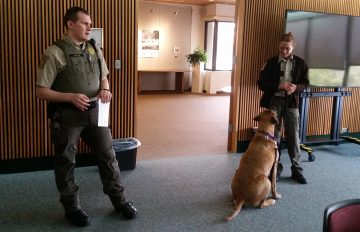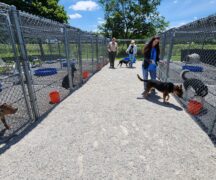By JAN LARSON McLAUGHLIN
BG Independent News
All 120 pounds of Winston with his wagging tail showed up in the Wood County Commissioners’ hearing room on Tuesday.
The mastiff mix – who was adopted from the Wood County Dog Shelter – was used to help exhibit the testing that dogs go through before they are deemed safe to be adopted out from the shelter.
“If we have dogs with unsafe behaviors, we are not going to place them,” Wood County Dog Warden Andrew Snyder said to the county commissioners. “We are making decisions based on the best interest of the public and best interest of the dogs.”
Snyder talked about Safety Assessment for Evaluating Re-homing tests intended to judge dog behavior. “This assessment was designed to identify behavior modification before adoption,” he said. However, the dog shelter does not have the adequate time or staff to perform the detailed two-person videotaped evaluations, he said.
“It’s really not a function we are equipped to carry out,” Snyder told the commissioners.
So the Wood County Dog Shelter is using its own version of the behavior evaluations. According to Snyder, dog shelters in Lucas and Hancock counties also do modified versions, while dog shelters in Seneca, Sandusky, Henry and Ottawa counties have no formal evaluations.
But a canine advocate group called Wood County Canine Alliance believes some dogs at the local shelter are unfairly labeled as dangerous and doomed to euthanasia.
Snyder defended the evaluations as a public service.

Dog Warden Andrew Snyder with Nora Davis and Winston
With the help of Winston and his owner, deputy dog warden Nora Davis, Snyder showed the county commissioners how dogs are assessed. Observation of the dog’s body language can tell a lot, he said. Is the dog barking in a happy or aggressive manner, cowering in the back of a kennel, pacing, acting dominant or submissive, avoiding eye contact? Are the ears back, hair raised, tail wagging?
“Dogs are very, very good at reading people,” Snyder said. “As we’re assessing them, they are assessing us.”
Then there are the tests. Will the dog tolerate having its feet touched or its ears tugged? Will it allow a person to push or restrain it in a hug? The staff uses a fake arm on a stick to see if the dog will allow its food bowl to be moved around.
There are also tests to see how a dog behaves around other dogs.
Snyder recognizes the evaluations are not perfect.
“We are evaluating dogs based on a single point in time,” and when being housed in a dog kennel, that point in time is not ideal, he said.
“It’s a stressful environment. Dogs certainly act different there than they will act in a home environment,” he said.
“All evaluations to a certain extent are subjective,” Snyder said.
Sometimes the shelter staff encounters a dog that behaves well – until a trigger occurs. Snyder told of a friendly dog whose behavior changed when it was grabbed by the collar.
“That dog would become unbelievably aggressive, like a light switch was flipped,” he said. “We don’t always know exactly what the trigger is.”
Some dog advocates have suggested that dogs be ranked as less dangerous if their bites tend to be less severe.
“That’s a flawed system as well,” Snyder said. Last year, Wood County recorded 155 dog bites. “We see a lot of gruesome injuries caused by dogs.”
Others have suggested that dogs who don’t like children or men, be placed with households without those triggers. But that only works if the dog is never in contact with children, men or whatever the trigger may be.
“If we have pre-existing knowledge of these behaviors, how liable does that make us when we send that dog out,” Snyder said. “We have a duty to take that into consideration.”
Dog wardens are not required to conduct behavior evaluations, but Snyder considers the observations important.
“We have a public safety duty,” he said. “We have to document what we observe and disclose that to the public.”
In addition to behavioral evaluations, the shelter also wants those people adopting dogs to get acquainted before they make the big commitment.
“We want adopters and rescuers to thoroughly evaluate these dogs themselves to see if it’s a good fit for them,” Snyder said.
Last year, using the evaluation system, the shelter staff determined 328 dogs were adoptable, 86 were deemed not adoptable, and 12 were for rescue only. A total of 74 dogs were euthanized last year.
“It’s truly rewarding,” to see so many dogs be reunited with families or find new homes, Snyder said.
But Connie Donald, of the Wood County Canine Alliance, believes many more dogs could find homes, but they are unfairly labeled as dangerous and never have a chance.
“I don’t think they can save all dogs, but it’s the ones they can” that she is speaking up for, Donald said Tuesday evening. “I’m disappointed.”
The modified evaluation system used at the shelter is flawed, she said, and results in non-aggressive dogs as being deemed unadoptable. “Typical, normal dog behaviors” are being labeled as dangerous.
“One of my concerns is the testers’ techniques,” Donald said.
People have higher standards for animal care, she said.
“We’re no longer satisfied with warehousing of dogs and euthanasia,” Donald said.





